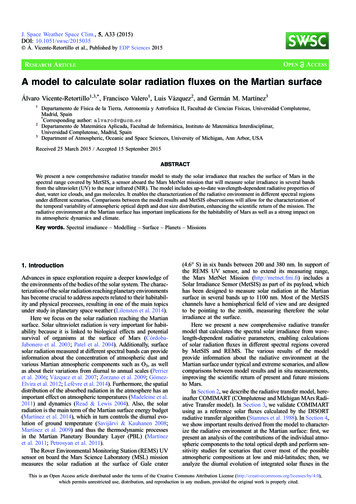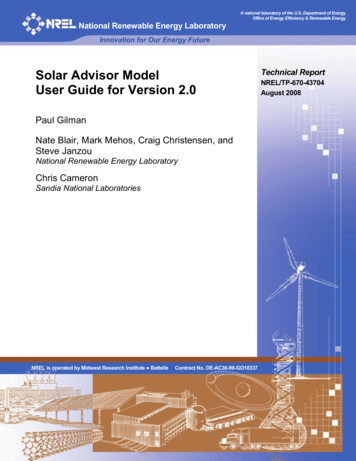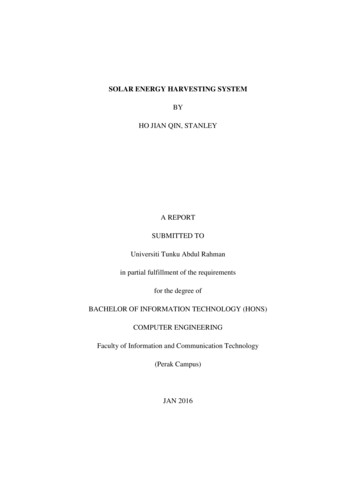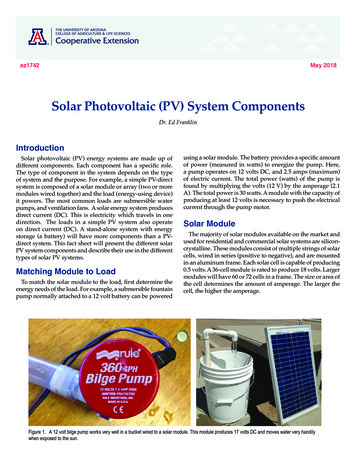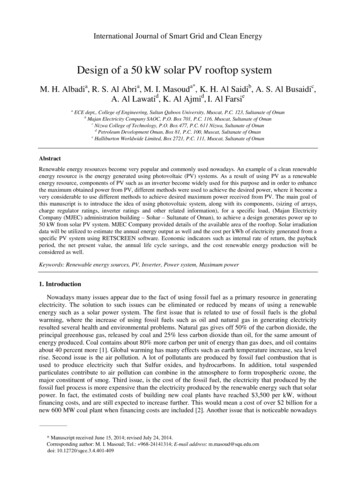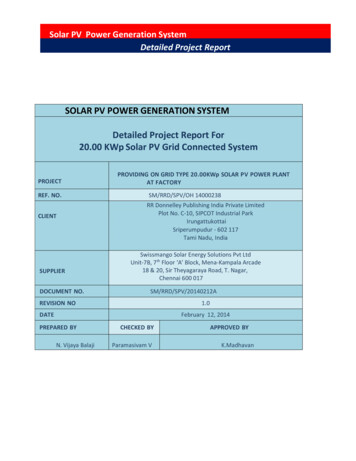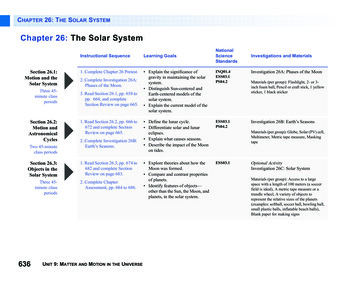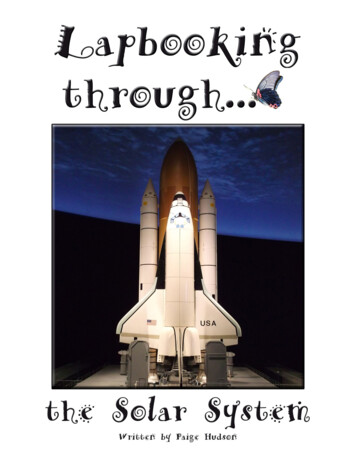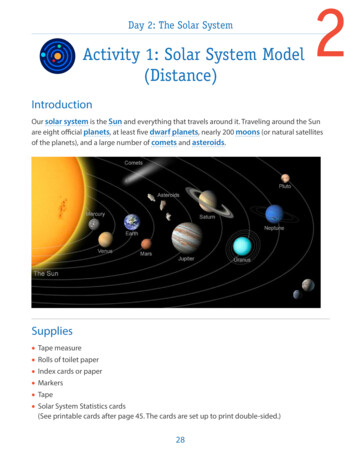
Transcription
Day 2: The Solar SystemActivity 1: Solar System Model(Distance)2IntroductionOur solar system is the Sun and everything that travels around it. Traveling around the Sunare eight official planets, at least five dwarf planets, nearly 200 moons (or natural satellitesof the planets), and a large number of comets and asteroids.Supplies Tape measure Rolls of toilet paper Index cards or paper Markers Tape Solar System Statistics cards(See printable cards after page 45. The cards are set up to print double-sided.)28
Day 2: The Solar SystemActivity 1: Solar System Model(Distance)2Get kids thinkingOur solar system is BIG! The sizes of the planets vary greatly as do the distances betweenplanets and their distance from the Sun. Start by asking about distances kids have traveled. How many miles is it from home to school? How much time does the trip take? How long would it take and how many miles would you have to travel from where you liveto get to London, England, or to La Paz, Bolivia? What about to Mars?Let's get started!Mars is relatively close to Earth, while the Sun and other planets even farther away. Talk aboutscale and how good a way to show the vast distances among the planets is to make a scalemodel that is smaller than the actual size of the solar system.Talk about the planets with the kids.Step 1: Identify the planetsAsk kids: Can they can name all the planets in the solar system? As you name them together, have kids write each planet name down on its own index cardor small piece of paper along with the average distance (in miles) of each planet from theSun. These are big numbers, so share the distance chart on page 31 to help. Instead of writing, kids can cut out and use the Solar System Statistics cards. (See printablecards after page 45. The cards are set up to print double-sided.) Once you have cards for each planet, have kids put them in order from nearest the Sun tofarthest.29
Day 2: The Solar SystemActivity 1: Solar System Model(Distance)2Step 2: Decide on the scale for your modelToilet paper sheets are going to represent the distances of planets from the Sun in this model.What’s fun about making this model is deciding the scale. If you have a lot of space , considera scale of 10,000,000 (10 million) miles equals 1 square of toilet paper. That will put Neptuneabout 1,100 sheets or 94 feet away from your “Sun.” (See the Expanded Distance Table on thefiollowing page if you plan to use this scale.) As you think about your scale, ask kids to estimate space available for the model. Have them measure a square of toilet paper and predict if their model will fit into theavailable space. Provide kids with a copy of the Expanded Distance Table. The table is for this scale:10,000,000 miles 1 square of toilet paper (95 feet of floor or outdoor space needed)Alternative scale optionsIf you do not have access to 95 feet of room, you can calculate the numbers for a scale thatrequires only about 20 feet of space. This is a good math challenge for kids who like to docalculations! 50,000,000 miles 1 square of toilet paper (19 feet of floor or outdoor spaceneeded)For younger kids, you can use this simplified chart below:PlanetSquaresAverage distance from SunMercury2.036 million milesVenus3.767 million milesEarth5.193 million milesMars7.7142 million milesJupiter26.4484 million milesSaturn48.4888 million milesUranus97.31.8 billion milesNeptune152.52.8 billion miles30
0VENUS92,957,10035,983,610MERCURYEARTHTrue AverageDistance to theSun in 28018088.848.414.29.36.73.6squaresDistance toSun in Sheets*(10,000,000 miles/sheet)* 4-inch toilet paper1,120720352.2193.656.837.226.814.4Distance to Sunin Inches93.36029.616.24.73.12.31.2Distance to Sunin FeetDistance BetweenEach Planet inSheets10,000,000 miles 1 square of toilet paper (95 feet of floor or outdoor space needed)Rounded AverageDistance to Sunin MilesExpanded Distance Table
Day 2: The Solar SystemActivity 1: Solar System Model(Distance)2Step 3: Make your model Make an index card for the Sun (or a construction paper Sun) and secure it on the ground(with tape if you are inside, set a rock on top of it if you are outside). Attach the toilet paper to the index card with tape. Lay the toilet paper down, slowly walk and unroll the toilet paper. (If you are outside and it iseven a little windy, get some rocks to hold the toilet paper in place.) As you unroll, count the number of squares. When you reach Mercury (3.6 sheets on a 10,000,000 milescale), use a marker to make a dot on the toilet paper andsecure the Mercury card next to that square. If you want to be precise about where to put the dot,turn a square of toilet paper into a tool that can help.(See photo on the right) Continue unrolling the toilet paper and placing the planetcards until you get all the way to Neptune! Far out, right?For an added challengeAsk kids if they have a plan for keeping track of their mileage.For example, Venus is 6.7 sheets from the Sun, but only 3.1 sheets from Mercury. Will they countsheets from the Sun for each planet? See if they can calculate the number of sheets betweeneach planet and add that information to their distance chart. Or, find out if they have anotheridea to keep their model accurate.32
Day 2: The Solar SystemActivity 1: Solar System Model(Distance)2Step 4: Talk about your modelNow that kids have an idea of the relative distance between planets, what do they think?Ask kids: Why is it important to know these distances? Who is it important to? How do the distances between planets get measured? What units are the best units for measuring these distances?As you discuss, be sure to explain to kids that the distances they used to create their modelrepresent the planets average distances from the Sun. Planetary orbits are elliptical and not circular, so the distances change depending on theplanet’s orbit. Also, be sure to point out that orbiting planets are never all in a straight line going out fromthe Sun as they are represented in this toilet paper model. And worth sharing: astronomers measure distances in the solar system in “astronomicalunits” or AU. 1 AU 93 million miles, the distance from the Sun to the Earth. Talk about what a solar system model that demonstrates the relative average distancesbetween the planets and the Sun and the relative sizes of the planets would look like.Save your Solar System Statistics cards for future activities.More model solar system activitiesScale Model of our Solar System (University of /solarsystem/The Thousand-Yard Model or, the Earth as a Peppercorn (National Optical Astronomy orn/pcmain.htmlSolar System Bead Activity solar-system-bead-activity/33
the Sun as they are represented in this toilet paper model. And worth sharing: astronomers measure distances in the solar system in “astronomical units” or AU. 1 AU 93 million miles, the distance from the Sun to


